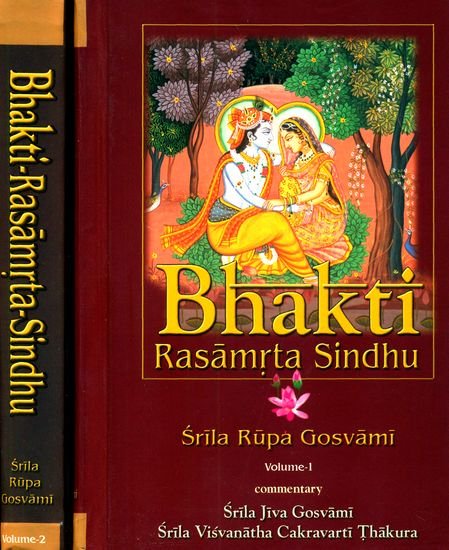Bhakti-rasamrta-sindhu
by Śrīla Rūpa Gosvāmī | 180,912 words
The English translation of the Sri Bhakti-rasamrta-sindhu verse 4.8.84; a medieval era Sanskrit book, written by Rupa Goswami (fl. 15th century) which represents a devotional (bhakti) masterpiece. In this work Goswami describes the nature and different forms of pure love (rasa) as well as various other topics on Vaishnavism and devotion.
Verse 4.8.84
Sanskrit text, Unicode transliteration and English translation:
तत्र रसानां विषयत्वे, यथा ललित-माधवे (३.४) —
दैत्याचार्यास् तद्-आस्ये विकृतिम् अरुणतां मल्ल-वर्याः सखायो
गण्डौन्नत्यं खलेशाः प्रलयम् ऋषिगणा ध्यान-मुष्णास्रम् अम्बाः ।
रोमाञ्चं सांयुगीनाः कम् अपि नव-चमत्कारम् अन्तः सुरेशा
लास्यं दासाः कटाक्षं ययुर् असित-दृशः प्रेक्ष्य रङ्गे मुकुन्दम् ॥४.८.८४॥tatra rasānāṃ viṣayatve, yathā lalita-mādhave (3.4) —
daityācāryās tad-āsye vikṛtim aruṇatāṃ malla-varyāḥ sakhāyo
gaṇḍaunnatyaṃ khaleśāḥ pralayam ṛṣigaṇā dhyāna-muṣṇāsram ambāḥ |
romāñcaṃ sāṃyugīnāḥ kam api nava-camatkāram antaḥ sureśā
lāsyaṃ dāsāḥ kaṭākṣaṃ yayur asita-dṛśaḥ prekṣya raṅge mukundam ||4.8.84||
English translation
Kṛṣṇa as the viṣaya of all rasas, from Lalita-mādhava:
“Seeing Kṛṣṇa in the combat arena, the priests of Kaṃsa showed disgust in their faces (bībhatsa), the wrestlers became red with anger (raudra), the cheeks of Kṛṣṇa’s friends raised up with smiles (hāsya, sakhya), the evil rulers became senseless (bhayānaka), the sages became fixed in meditation (śānta), the mothers wept with hot tears (karuṇa, vatsala), the expert warriors’ hairs stood on end (vīra), the devatās felt novel internal attachment (adbhūta), the servants began to dance (dāsya) and the young women cast glances from the corners of their eyes (madhura).”
